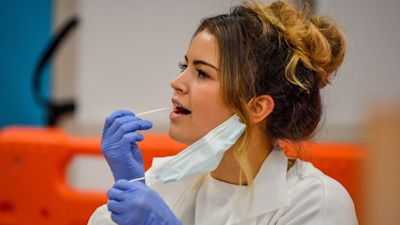Omicron mutation BA.2 declared 'variant under investigation' by health experts but cases remain low

The UK health agency has declared a sub-lineage of Omicron a "variant under investigation" (VUI) after a rise in the number of Covid-positive cases showing the sequences.
The variant has been reported in 40 countries, with Denmark seeing the biggest rise in BA.2 cases. India, South Africa and Sweden have all reported cases.
It has not been designated a variant of concern and the UK Health Security Agency (UKHSA) said further analysis will be carried out into the sub-variant.
It is causing some alarm among scientists over fears it could be more transmissible, but so far too little is known about it to draw any definitive conclusions.
As of January 21, 2022, 426 sequences of BA.2 have been identified in the UK, according to the UKHSA.
What is BA.2 and how does it relate to Omicron?
Most cases of Omicron are the BA.1 variant but the sub-lineage BA.2 is being detected across the world.
It was first designated as a variant on December 6 and was detected in the UK on the same day.
BA.2 is very similar to BA.1, and they are both considered to be Omicron.
Listen to our coronavirus podcast:
The key difference right now is when detected by a PCR test it comes up as S-gene positive (SGTP), whereas BA.1 does not.
The fact BA.1 lacked the S-gene was key to detecting and tracking the spread of Omicron early on.
It is also the easiest and most widely used method of identifying if a case of Covid-19 is Delta or Omicron.
This means with BA.2 now showing S-gene positive it is becoming harder to track and distinguish from other variants.
The UKHSA has noted 5% of Covid tests that have the S-gene are now BA.2 making S-gene tracking "no longer sufficient to assess the spread of Omicron as a whole".
The UKHSA also said: "There is still uncertainty around the significance of the changes to the viral genome, and further analyses will now be undertaken."
Is it more transmissible than normal Omicron?
The growth of BA.2 in places where BA.1 is dominant has led to fears it could be more transmissible, but scientists have emphasised not enough is known to draw any conclusions.
The UKHSA said: "Early analysis suggests an increased growth rate compared to BA.1, however, growth rates have a low level of certainty early in the emergence of a variant and further analysis is needed."
In the UK the areas with the largest number of confirmed cases are London (146) and the South East (97).
In Denmark, where BA.2 makes up around 50% of cases , the country's Statens Serum Institut, part of its ministry of health, has said hospitalisations appear to show no difference for the two Omicron lineages but that "analyses regarding infectiousness and vaccine efficiency etc. are ongoing".
Should we be worried?
There is no evidence on whether BA.2 is more or less severe than other variants of COVID-19.
Tom Peacock, a virologist at Imperial College London, said on Twitter the earliest indications from Denmark and India "suggest there is no dramatic difference in severity compared to BA.1".
Peacock also said: "There is likely to be minimal differences in vaccine effectiveness against BA.1 and BA.2."Dr Meera Chand, Covid-19 Incident Director at UKHSA, said: "It is the nature of viruses to evolve and mutate, so it’s to be expected that we will continue to see new variants emerge as the pandemic goes on.
"Our continued genomic surveillance allows us to detect them and assess whether they are significant.
"So far, there is insufficient evidence to determine whether BA.2 causes more severe illness than Omicron BA.1, but data is limited and UKHSA continues to investigate."